Odekon M. Encyclopedia of paleoclimatology and ancient environments
Подождите немного. Документ загружается.


center stage as one of the main contributors to our understand-
ing of the system that drives Earth’s evolution. ODP focuses its
inquiry into the physics, chemistry, and biology of the Earth’s
processes using two basic data collection strategies: (a) drilling
holes in oceanic crust and extracting core samples and (b)
inserting instruments into the holes to measure conditions such
as pressure, temperature, and chemistry of the pore waters.
Scientists from every major scientific specialty use all the tools
available to them both in ship and shore-based laboratories to
analyze samples and measurements in an effort to compile the
data needed for a thorough, multidisciplinary understanding
of the processes taking place in and on the seafloor.
Deep sampling of the sedimentary layer of oceanic crust
actually began in 1947 with the invention of the Kullenberg
piston corer which was able to penetrate to the Pleistocene and
late Pliocene sedimentary layers. Through the 1950s and early
1960s, scientists were able to gather samples as old as the upper-
Cretaceous (Kennett, 1982;Hay,1988). Long piston cores pro-
vided the first evidence that sedimentary accumulations in deep
sea basins are highly variable and subject to constantly changing
environmental processes.
In the early 1960s, improvements in deep sea drilling technol-
ogy warranted a proposal to launch a national program to drill
through the Mohorovičić Discontinuity, the boundary between
the crust and the mantle. The ambitious plan was to penetrate
6 km of crustal rock below the sea floor in the Pacific Ocean basin.
Known as the Experimental Mohole Project, the plan was
scrapped after a few test holes due to unanticipated technology
problems resulting in substantial cost overruns. Even though the
Project was thought to be a dismal failure, samples obtained
while drilling from a floating vessel demonstrated to scientists
the enormous potential value of geological explorations in oceanic
crust, which covers over 70% of the Earth’s surface, rather than
restricting research to the continental crust.
By 1964, four U.S. oceanographic institutions (Miami Uni-
versity, Columbia University, Woods Hole, and Scripps) had
joined together in a consortium known as the Joint Oceano-
graphic Institutions for Deep Earth Sampling (JOIDES) and
proposed to the National Science Foundation a program of con-
tinuous coring to depths of more than 1 km off the coasts of
Florida and Trinidad. Deep sea sediments recovered from six
drillholes contained long sequences of well-preserved micro-
fossil assemblages useful for global stratigraphic correlations.
The Mohole Project and the JOIDES holes, as they were
called, thus laid the foundation for a campaign of scientific
ocean drilling that, over the past four decades, has yielded a
treasure trove of core samples and downhole measurements
available to scientists all over the world.
On July 20, 1968, the Glomar Challenger, an existing vessel
modified specifically for scientific ocean drilling, set sail as
the flagship of the Deep Sea Drilling Project (DSDP), initially
designed as an 18-month project to drill in the Atlantic and Pacific
oceans. DSDP was so successful that in the early 1970s other
U.S. and foreign institutions joined JOIDES in support of the pro-
gram, thus providing more stable funding for ongoing operations.
DSDP continued operations for more than a decade, gradually
increasing its international participation and its range of deep-
sea explorations. In 1985, a new, larger, and more sophisticated
scientific research vessel began operations, launching the Ocean
Drilling Program, a brand new program of scientific ocean drill-
ing. Operated by Texas A&M University, the drillship JOIDES
Resolution is a “floating university,” fitted with modern drilling
equipment as well as numerous fully-equipped laboratories for
sample measurement and analysis.
ODP has explored all of the world’s oceans, from the Arctic to
the Weddell Sea near Antarctica, collecting sediment and rock
samples, recording downhole geophysical and geochemical data,
and establishing long-term borehole observatories. Since the
JOIDES Resolution first sailed in January 1985, she has put to
sea six times a year, every year with a contingent of scientists,
students, drilling specialists and crew, who leave politics and
national identity behind in favor of getting the job done. As of
mid-2002, ODP has collected almost 700,000 feet (215 km) of
cores from over 1,700 holes. Participants in the Ocean Drilling
Program include 18 U.S. institutions and 22 international partners.
An estimated 2,700 scientists from more than 40 nations have
participated in ODP expeditions and countless more have used
ODP samples and data in their research. All ODP core samples
and related measurements are carefully preserved in depositories
and archives and are made available for study to scientists from
all countries, institutions, and disciplines.
ODP research objectives
The impetus for deep sea drilling has been to collect sediment
and rock samples from oceanic crust in an effort to define and
understand the evolution of the planet. One of the most fortui-
tous aspects of ODP is that evolving technology for scientific
ocean drilling coincided with recently developed theories of
continental drift, sea-floor spreading, and shifts in the planet’s
magnetic field. Theories of slowly drifting landmasses, known
as plate tectonics, were first proposed in the early twentieth
Century by Alfred Wegener, but scientists lacked the tools
and technology to test his intriguing hypotheses. The advent
of scientific ocean drilling has allowed the collection of data
to test and confirm plate tectonics as well as many other
hypotheses concerning the geodynamics of natural events like
earthquakes and volcanoes, and theories of crustal age and its
relationship to the magnetic properties of rocks.
From the outset, ODP researchers have sought to understand
the dynamics of Earth’s geophysical and geochemical pro-
cesses, focusing on:
1. climate and sea level variability
2. the nature and movements of sediments and fluids in and
on the oceanic crust
3. the deep structure of continental margins and mantle-crust
interactions
4. the nature and functions of life forms within the oceanic
crust
ODP contributions to Earth science
The Ocean Drilling Program’s approach to scientific investigation
derives from the recognition that Earth is a complex, multidimen-
sional, dynamic system that is constantly changing. Some changes
may be considered rapid in geologic time – for example, ice sheets
can fluctuate dramatically over a few thousand years. Other
changes occur so gradually that their effects are not at all apparent,
even over hundreds of millennia. Geologists have learned to ana-
lyze data within theoretical models that can collapse millions
of years into time scales in which changes can be described and
interpreted. Although any division of the components of Earth’s
system is arbitrary, oceanographers must subdivide their theore-
tical approaches and hypotheses in order to tackle manageable
scientific questions. Over the years, ODP has concentrated its
630 OCEAN DRILLING PROGRAM (ODP)
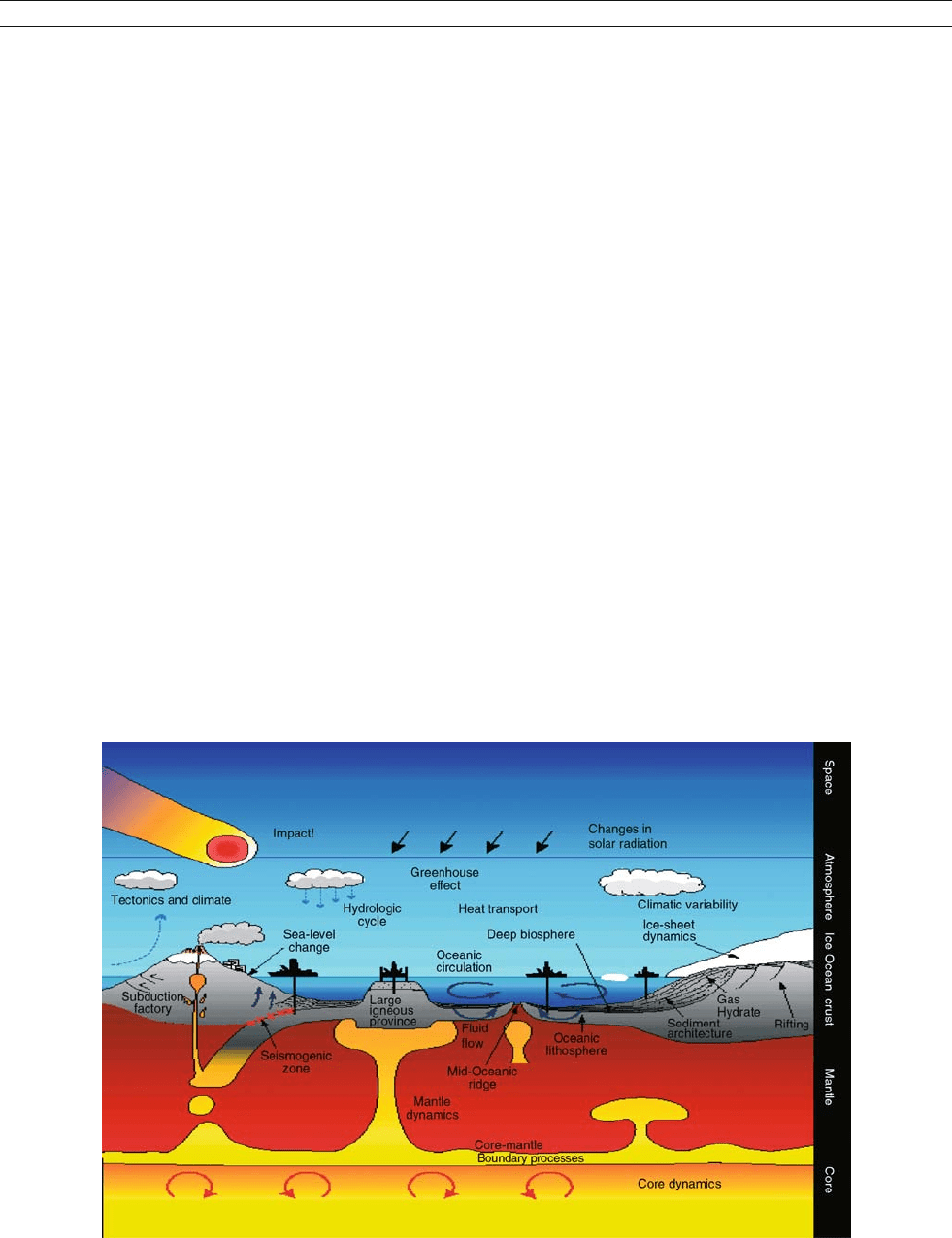
efforts within a number of broad scientific themes: climate and sea
level variability; sediments, fluids, and bacteria as agents of sys-
tem change; heat and mass transfer within the Earth’s crust and
mantle;and deformation mechanisms withinthe lithosphere which
contribute to natural catastrophic events such as earthquakes, vol-
canoes, and massive landslides under the ocean.
Climate change
The Earth’s climate exhibits cycles of warming and cooling
as well as episodes of rapid climate change. Geologists from
a wide variety of disciplines have employed an extraordinary
number of investigative approaches to identify and quantify cli-
mate variability, and the various agents of change within
Earth’s dynamic climate system. This area of research is critical
to understanding natural climate cycles, as well as impacts on
local and global climate of natural and man-made perturbations
in the system.
Climate is affected by atmospheric composition, planetary
orbital oscillations, ocean circulation patterns and carbon flux,
biological productivity and evolution, land surface alterations,
sea-level fluctuations, and the global distribution and volume
of ice. Climate change in turn impacts many of these factors
such that a feedback system exists between physical, chemical,
and other ecosystem elements (Figure O4). Identifying cause
and effect relationships requires data from widely diverse geo-
graphic locations and from as many time periods as possible.
One method for measuring climate change comes from exam-
ining stable isotopes of oxygen, carbon, and nitrogen, and the
presence of particular elements within microfossils in sediment
deposits. The ratio of oxygen isotopes and the concentration
of certain elements in the fossils vary predictably with the tem-
perature at which the animals lived. These measurements allow
scientists to extrapolate their findings to make predictions about
other parts of the climate system, such as the waxing and waning
of ice volume over time (Lear et al., 2000).
Variations in carbon deposition is another indicator of cli-
mate change, since biologic productivity and turnover varies
with climate, and rates of biological activity can be measured
in depositions of biogenic sediments of the deep sea. The degree
of preservation of organic carbon in sediments is controlled both
by rates of productivity and degree of oxygenation of the bottom
waters.
Plate tectonics, popularly known as continental drift, has also
been implicated in major climactic variation due to alterations in
the distribution of freshwater and heat transport in the global
ocean. Through cores obtained from ocean drilling, scientists have
identified shifts in ocean currents, seawater salinity, and rates
and pathways of heat transport due to the reconfiguration of
oceans and continents, particularly the opening and closing
of oceanic gateways. One example is the closure of the Central
American Seaway, near Panama, which initially resulted in cli-
mate warming but ultimately led to major ice sheet development
in the Northern Hemisphere (Haug et al., 2001).
Fluctuations in sea-level are also seen as indicators of shifts
in the global climate. While local sea-level changes can be the
result of sediment shifting and plate movement, global sea-
level fluctuation is usually the result of changes in the global
volume of ice, and is directly associated with variations in
atmospheric and ocean temperatures. ODP has drilled a number
of sites, particularly in the New Jersey continental shelf and
Bahama Islands, in an effort to identify those sea level varia-
tions that are the result of local effects versus those that result
from global climate change.
Large shifts in climate can also occur as a result of cata-
strophic natural events. An event such as a volcanic eruption
or a meteor striking the Earth can produce sufficient change
in the composition of the atmosphere to cause an overall warm-
Figure O4 Earth system components, processes, and phenomena (courtesy of Asahiko Taira, Japan Marine Science and Technology Center).
OCEAN DRILLING PROGRAM (ODP) 631
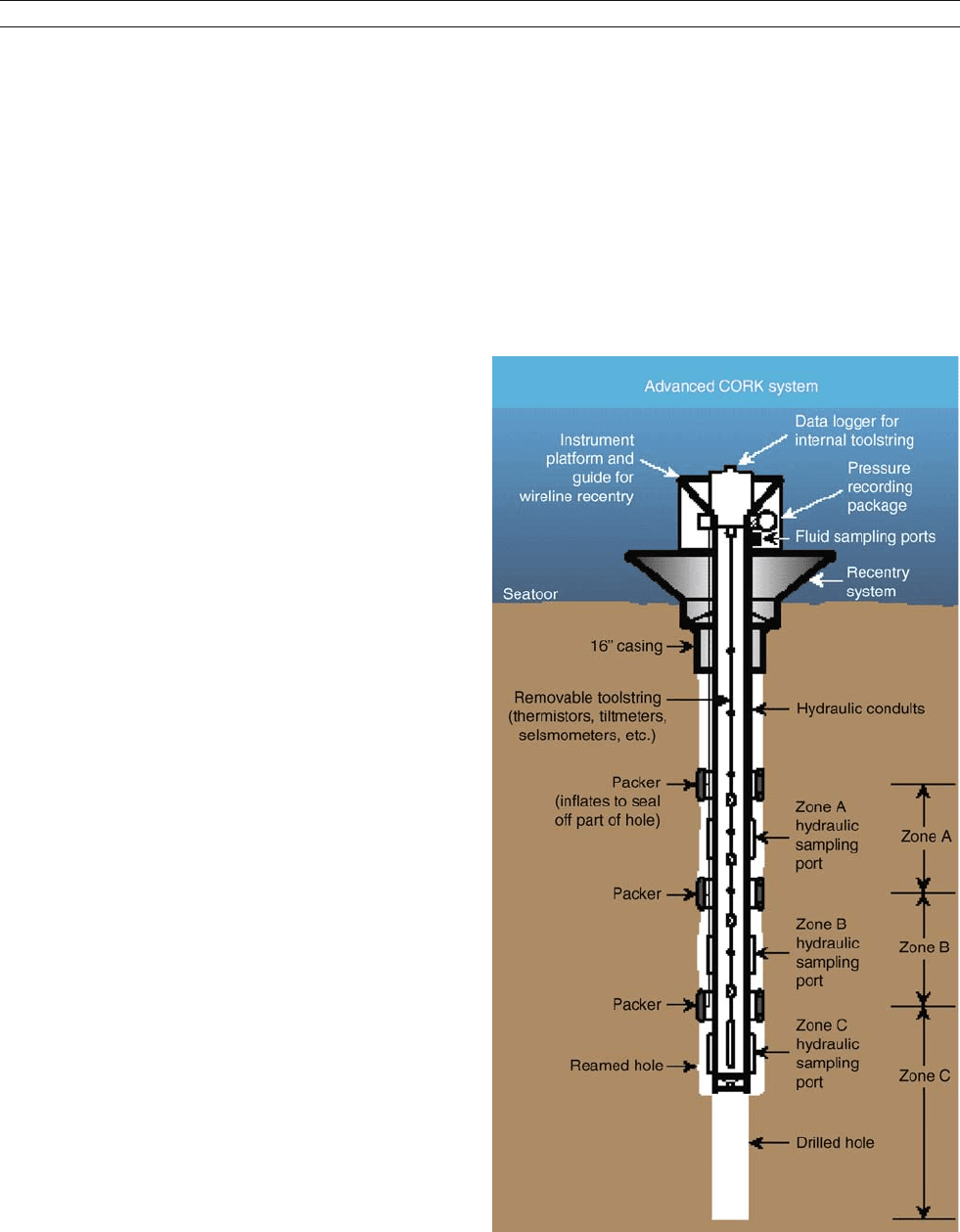
ing of the global climate and even widespread extinctions of
biological species. Such an event is thought to have occurred
about 65 million years ago. A large extraterrestrial object, prob-
ably a meteor, apparently slammed into Earth at what is now
Mexico’s Yucatan Peninsula. In 1997, ODP drilled into sites
300 miles off northeastern Florida, extracting cores containing
sedimentary layers that reveal in beautiful detail a cataclysmic
story of destruction and biotic upheaval. The cores exhibit sedi-
mentary layers of debris from the impact consisting of a layer
of green, glassy globules and mineral grains, a succeeding
layer showing remains of the meteorite but devoid of almost
all life, and succeeding layers showing the return of micro-
organisms. The cores that document what is now known at
the Cretaceous-Tertiary (K/T) boundary enable scientists to
conduct geochemical and paleontological studies of the post-
apocalyptic repopulation of the ocean (Norris, 1997).
Architecture of planet Earth
By convention, our planet is described as being made up of three
major sections, an inner molten core, the mantle, which is com-
posed mostly of solid igneous rock, and the crust, consisting of
regions of consolidated rock, layers of sediment, and pockets
of gases and fluids inhabited by microorganisms. In fact, these
components of the planet are in motion and interacting with each
other all the time. We see the effects of crustal and upper mantle
motion in the form of volcanoes, earthquakes, faults, geysers,
and other natural phenomena. The Ocean Drilling Program has
focused a great deal of attention on describing the movement of
rock, sediments, gases, and fluids in the oceanic crust and mantle.
Core samples from the far reaches of the global ocean have con-
firmed the theory of plate tectonics by comparing sedimentary
deposits, magnetic signatures, and crustal rocks from geographi-
cally disparate sites. Over the past two decades, ODP research has
improved our understanding of Earth’s deep mantle using numeri-
cal simulations, images derived from global seismic tomography,
and experimental studies of materials at simulated mantle condi-
tions. These studies suggest mantle architecture and dynamics that
are considerably more complex than simple layering.
A dramatic example of plate tectonics, or continental drift, is
apparent in the Atlantic Ocean. Until about 140 millions years
ago, a narrow, shallow seaway lay between Europe and North
America. The European and North American plates began to
shift, resulting in a spreading of the seafloor and the formation
of the Atlantic Ocean. A combination of geophysical measure-
ments and studies of drill cores obtained by ODP off the coast
of Portugal documents this gradual phenomenon by measuring
the thickness of the crust and determining that the continental
crust became shallower as it spread. It broke up when it had
thinned to about 7 km, resulting in a crust-free zone of exposed
mantle at the seafloor. Many of the rock cores have now been
dated using radioactive isotopes to demonstrate that the focus
of stretching of the crust and mantle migrated from the conti-
nent towards the ocean (Whitmarsh et al., 2001).
Another major focus of ODP technological and research effort
has been the placement of long-term observatories in the ocean
floor. Dubbed CORKs, these observatories are designed to docu-
ment the flow of heat and chemicals within the interior of the crust
by measuring temperatures, pressures, and compositions of fluids
(Figure O5). CORKS have been placed on the axis and flank of
the Juan de Fuca Ridge in the northern Pacific, and the flank
of the Costa Rica Rift and the Nankai and Mariana subduction
zones. Data from CORKs show that changes in mechanical and
fluid-flow properties of rock formations result from plate strain,
notably at sites where earthquakes occur. Thus, research from
CORKs is helping to explain the relationship between episodic
plate motion, deformation, and earthquake energy release (Davis
and Becker, 1998).
Observatories can also be used to measure seismic activity
in crustal deformations offshore, too far for land-based measur-
ing instruments to reach. ODP emplaced such an observatory
offshore of northeast Japan, more than 1,000 m below the sea
floor in water depths of 2,000 m. This observatory is designed
to sense movement at plate boundaries, called subduction
zones. Interpretations of measurements allow geophysicists to
determine whether plate movement is creating plate boundary
strain that could eventually erupt in a violent earthquake. Earth-
Figure O5 Advanced Cork System (courtesy of Earl Davis, Geological
Survey of Canada and Keir Becker, University of Miami).
632 OCEAN DRILLING PROGRAM (ODP)
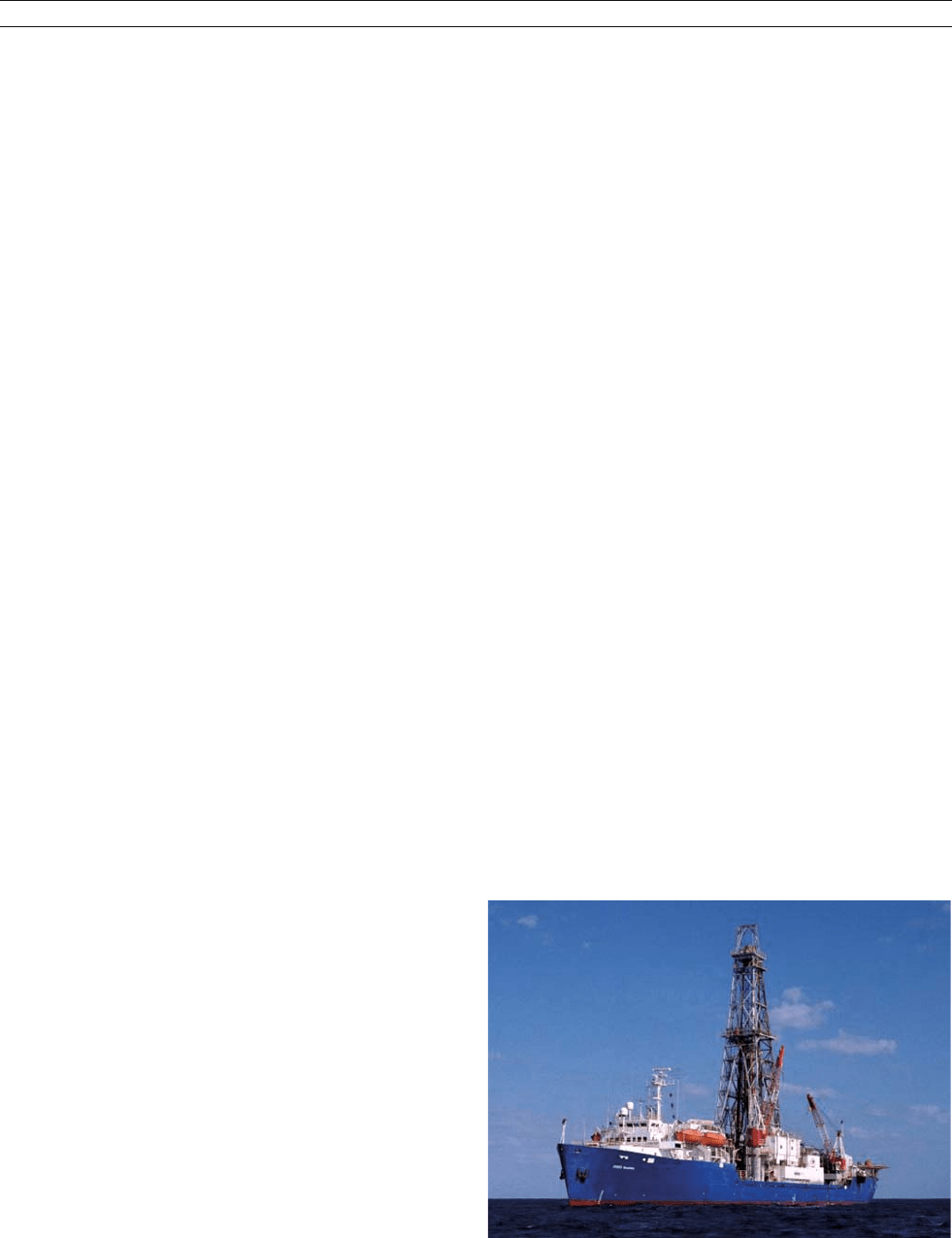
quakes are devastating manifestations of plate movement, but
only represent a portion of the total energy storage and release
being created at subduction zones. ODP observatories help us
see the whole picture, allowing better prediction of natural
hazards (Suyehiro, 2002).
Drilling through the entire thickness of Earth’s crust has
been a challenge since the very beginning of scientific ocean
drilling. Scientists define the architecture of oceanic crust by
comparing the seismic signature of the crust in the oceans to
the various pieces of oceanic crust found on continents. ODP
recently drilled one hole in the Pacific to a depth of 2,111 m
below the sea floor – the deepest scientific hole drilled in the
ocean. Another expedition extracted 1.5 km of rock core from
below the seafloor at the Mid Atlantic Ridge. Core samples
from the deep crust provide valuable information on deforma-
tion structures and rock composition from which interpretations
of tectonic activity can be derived (Dick et al., 2000).
Deep biosphere
Living microorganisms have found a comfortable home in the
various ecological niches of Earth’s crust, from shallow sedi-
mentary layers to deep regions of basalt rock. Until recently,
it was assumed that the deep crust was a sterile, lifeless place,
undisturbed by the messiness of organic metabolic processes.
In the past two decades, ODP research has discovered a wide
variety of microbial life forms deep within oceanic crust. Dril-
ling has unearthed bacteria living as deep as 800 m below the
seafloor, much deeper than was previously thought possible
given the extreme temperatures and pressures in the deep crus-
tal environment. Estimating the size and ecological impact of
this so-called deep biosphere is a major scientific goal of
ODP. While the concentration of living organisms in Earth’s
crust is small, the global volume of crust is enormous, indicat-
ing that crustal organisms may represent a significant fraction
of the Earth’s biomass (Parkes et al., 1994).
Recent research indicates that the ability of bacteria to cycle
between active and dormant states in response to nutrient levels
may answer one of the mysteries of how they survive in such
inhospitable environments. Indeed, microbial activity has even
been found in reservoirs of volcanic glass, suggesting that
the microbes are metabolizing minerals as an energy source.
Microbes in volcanic crust may be important catalysts of che-
mical change, and may help to regulate the cycling of elements
between seawater and oceanic crust. The existence of such life
forms that derive their energy from inorganic chemical reac-
tions suggests that life may thrive in previously unsuspected
places, such as on Mars and Europa (Fisk, 1997).
Bacteria isolated from continental hydrothermal environ-
ments have already made a major impact on biotechnology in
areas like bioremediation, waste treatment, microbial enhanced
oil recovery, and biominerals. Some bacterial populations
appear to have survived for millions of years, suggesting they
have some remarkable enzymes and metabolic processes. The
seafloor may turn out to be an especially suitable setting for
sampling the deep biosphere and measuring microbiological
processes and fluid flow in support of biological communities.
Subseafloor environments are often more stable and struc-
turally less complicated than terrestrial environments. Drilling
and core collection strategies are being developed to assure
samples relatively uncontaminated by human activity.
Microbiology has become an integral part of ODP explora-
tions. The drillship has a well-equipped microbiology labora-
tory that allows seagoing scientists to collect samples from
cores for experiments and analysis both immediately onboard
and preserved for shore-based study. The results of these
studies will contribute to our understanding of how the Earth
and its inhabitants have co-evolved (Smith, 2002).
ODP technology
The ODP collects samples from the Earth’s crust in locations
that are not only great distances from shore-based laboratories
but incredibly difficult to reach. ODP drilling sites may be
thousands of miles from shore and more than 8 km below the
ocean surface. ODP adapts technology developed by oil explo-
ration companies, as well as engineering specialized drilling
tools as required by scientists’ research goals. The centerpiece
of the ODP is the 143 m long drillship JOIDES Resolution
(Figure O6). For more than two decades, this ship has made at least
six expeditions a year to drill cores and take measurements inside
the boreholes in all but very shallow, very deep, or ice-covered
oceans. The ship is equipped with over a thousand square feet of
state-of-the-art geophysical, geochemical, and microbiological
laboratories, and accommodates 50 scientists and technicians
and an equivalent complement of crew members.
ODP cores and downhole measurements are the priceless
data that are used by both seagoing and shore-based scientists
to conduct analyses, test hypotheses, and develop theories of
how all the elements of the Earth system function. Cores are
obtained by lowering a string of drill pipe through an opening
in the ship’s hull, called the moon pool, down to the seafloor.
Core barrels, containers for the core, are lowered within the
pipe. They collect core samples as the drill bit chews through
the seafloor. Once the core arrives on deck, all scientists and
technicians are busy taking measurements of its geophysical
and geochemical properties, such as density, porosity, and mag-
netism. The core is then halved, with the working half being
prepared for sampling and the archive half kept in pristine
condition and saved for future research. Scientists spend much
of their time on board measuring and analyzing core samples
for composition, grain size, age, and color. At the end of the
cruise, all cores are sent to one of four onshore repositories
where they are stored in a temperature-controlled environment
for future research.
The borehole left behind is also a source of valuable data
that is collected and stored with care equal to the cores them-
Figure O6 ODP drillship JOIDES Resolution.
OCEAN DRILLING PROGRAM (ODP) 633

selves. Downhole measuring tools are placed in the hole on
wirelines both during and after extracting the core. Instruments
attached to the wireline continuously measure geophysical con-
ditions such as temperature, pressure, fluid flow, and magnet-
ism, all of which are critical to understanding the dynamic
processes in the environment from which the cores were
extracted. These logging tools also include imaging tools that
create a detailed “picture” of the inside of the borehole. These
data help scientists to develop models and theories of sediment
and rock structure, conditions and movements at plate bound-
aries, and shifts in crustal composition such as magma flows
and intrusions (Goldberg, 1997).
ODP organization and funding
The ODP is an international partnership of scientists and research
institutions organized to explore the evolution and structure of the
Earth. Its composition and membership has grown throughout
its thirty-year history to include the United States, Germany,
Japan, the United Kingdom, the Australia/Canada/Chinese
Taipei/Korea Consortium for Ocean Drilling, the European
Science Foundation Consortium for Ocean Drilling (Belgium,
Denmark, Finland, Iceland, Ireland, Italy, The Netherlands,
Norway, Portugal, Spain, Sweden, and Switzerland), the People’s
Republic of China, and France.
Member countries pool financial resources to fund ODP
research. Program resources are managed by a non-profit cor-
poration that subcontracts with various institutions to pro-
vide ship and logging operations, shore-based laboratories
and core curation, and dissemination of samples, data, and
research results.
ODPs research agenda has always been proposed and eval-
uated by participating ODP scientists. Individual scientists or
groups of scientists propose research projects to ODP. Propo-
sals are reviewed and evaluated by multidisciplinary panels
representing scientists from all ODP member countries and
institutions. The consortium of Joint Oceanographic Institu-
tions for Deep Earth Sampling (JOIDES) constitutes a series
of science advice panels and committees, which are charged
with evaluating not only the scientific merit of proposals, but
also considerations such as safety, likelihood of success, pollu-
tion prevention, and technological requirements.
This unique format brings together researchers and students
from universities, industry, and government laboratories in
member nations to work in modern, fully equipped shipboard
laboratories on focused scientific projects. The results of
research based on ODP cores, samples, and data are published
openly in leading scientific journals and in ODP publications.
Joanne C. Reuss
Bibliography
Davis, E., and Becker, K., 1998. Borehole observations record driving
forces for hydrothermal circulation in young oceanic crust. Eos, Trans.
Am. Geophys. Union, 79(31), 377–378.
Dick, H.J.B., et al., 2000. A long in-situ section of the lower ocean crust:
results of ODP Leg 176 drilling at the Southwest Indian Ridge. Earth
Planet. Sci. Lett., 179,31–51.
Fisk, M.R., 1997. Evidence for Microbes inOceanic Balasts: Glass-Eating
Bacteria? ODP’s Greatest Hits; Contributions from the U.S. Scientific
Community. Washington, DC: Joint Oceanographic Institutions, 15.
Goldberg, D., 1997. The role of downhole measurements in marine
geology and geophysics. Rev. Geophys., 35–3, 315–342.
Haug, G.H., Tiedemann, R., Zahn, R., and Ravelo, A.C., 2001. Role
of Panama uplift on oceanic freshwater balance. Geology, 29, 207–210.
Hay, W.W., 1988. Paleoceanography: A Review for the GSA Centennial.
Geol. Soc. Am. Bull., 100, 1,934–1,956.
Kennett, J., 1982. Marine Geology. Englewood Cliffs, NJ: Prentice-Hall,
811pp.
Lear, C.H., Elderfield, H., and Wilson, P.A., 2000. Cenozoic deep-sea
temperatures and global ice volumes from Mg/Ca in benthic forami-
niferal calcite. Science, 287, 269–272.
Norris, R.D., 1997. Records of the Apocalypse: ODP Drills the K /T
Boundary, ODP’s Greatest Hits; Contributions from the U.S. Scientific
Community. Washington, DC: Joint Oceanographic Institutions, 9.
Parkes, R.J., Cragg, B.A., Bale, S.J., Getcliff, K., Goodman, P.A., Rochelle,
J.J.F., Weightman, A.J., and Harvey, S.M., 1994. Deep bacterial
biosphere in Pacific Ocean sediments. Nature, 371, 410–413.
Smith, D.C., 2002. Microbes: Life Deep Beneath the Seafloor,
ODP Highlights; International Scientific Contributions from the
Ocean Drilling Program. Washington, DC: Joint Oceanographic
Institutions, 6.
Suyehiro, K., 2002. The Earth’s Next Move, ODP Highlights; Interna-
tional Scientific Contributions from the Ocean Drilling Program.
Washington, DC: Joint Oceanographic Institutions, 25.
Whitmarsh, R.B., Manatschal, G., and Minshull, T.A., 2001. Evolution
of magma-poor continental margins from final rifting to seafloor
spreading. Nature, 413, 150–154.
Cross-references
Carbon Isotopes, Stable
Climate Change, Causes
Cretaceous/ Tertiary (K-T) Boundary Impact, Climate Effects
Deep Sea Drilling Project (DSDP)
Oxygen Isotopes
Plate Tectonics and Climate Change
Sea Level Change, Last 250 Million Years
Stable Isotope Analysis
OCEAN PALEOCIRCULATION
Introduction
Because of its impact on global climate, one of the most
important aspects of ocean circulation is the rate of meridional
overturning (also called “Conveyor Belt” or thermohaline cir-
culation) (Figure O7; see Thermohaline circulation). In the
Atlantic Ocean, the meridional overturning circulation (MOC)
brings heat from the tropics to high northern latitudes, which
ameliorates the climate of the northern continents (Broecker,
1997). Changes in the rate of the Atlantic MOC and in the
associated production of the North Atlantic Deep Water
(NADW) may thus have been directly implicated in the large
climatic cycles and abrupt climate changes that characterize
the Quaternary period and may have contributed to the waxing
and waning of the large continental ice sheets that covered
North America and Northern Europe during glacial times
(see Quaternary climate transitions and cycles). Changes in
the global ocean circulation could have also played an indirect
role in altering the Earth’s climate by influencing atmosphe-
ric CO
2
and greenhouse warming (see Ice cores, Antarctica
and Greenland). Lower rates of deep-water ventilation would
engender greater sequestration of carbon in the deep sea,
resulting in lower atmospheric CO
2
and cooler temperatures
(Toggweiler, 1999). Reconstructing past changes in ocean cir-
culation (i.e., ocean paleocirculation) is thus an integral part
of understanding the evolution of climate and has been subject
to intensive scientific scrutiny for several decades.
634 OCEAN PALEOCIRCULATION
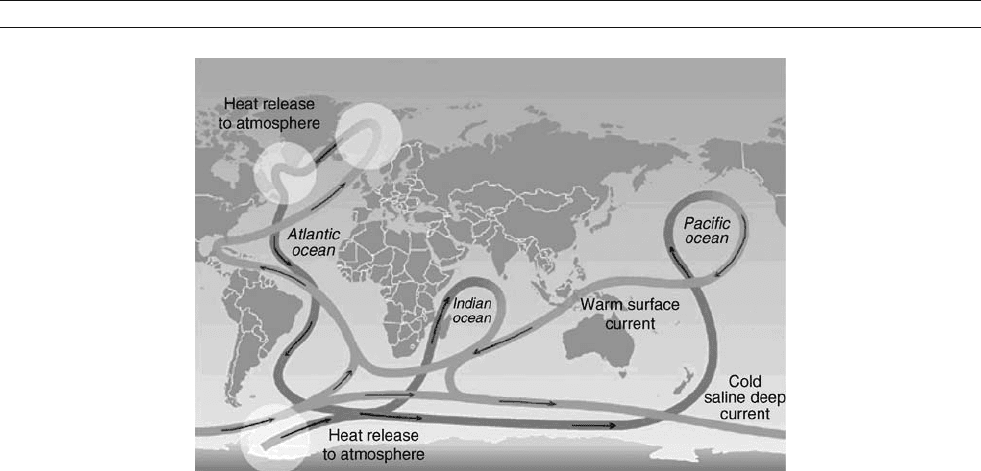
Reconstructing paleocirculation
The chemical and isotopic composition of marine sediments
and skeletal remains of organisms that grow on the seafloor
is one of our main sources of information for evaluating
past changes in ocean circulation in relation to climatic varia-
bility. Changes in ocean circulation impart distinct chemical
and isotopic signatures to seawater that are recorded in the car-
bonate shells of benthic foraminifera (i.e., protozoans living on
the seafloor), in the carbonate skeletons of deep-sea corals and
in the sediment accumulating on the seafloor. Results obtained
from these geochemical tracers (or proxies) clearly reveal that
significant changes both in the distribution of water masses
and in the rate of deep-water circulation took place in the past,
in concert with important climatic events. Reconciling the
detailed interpretation of these different and sometimes con-
flicting proxies is yielding an increasingly clear depiction of
how deepwater circulation contributed to or responded to past
global climate changes.
Geochemical tracers of deep-water circulation can be
broadly divided into two categories: (a) water mass tracers
and (b) kinematic tracers of ocean circulation. Both types of
tracers are complementary and necessary to fully document
past changes in deep water circulation. The water mass tracers
are better suited for reconstructing past expansions or contrac-
tions of the different water masses that fill the deep ocean
basins, while kinematic tracers are necessary to constrain past
changes in the rate at which volumes of deep water were pro-
duced (expressed in Sverdrups ¼ 10
6
m
3
s
1
).
Underlying principles
Proxies for water mass identification
In the deep Atlantic Ocean, two antagonistic water masses, the
North Atlantic Deep Water (NADW) and the Antarctic Bottom
Water (AABW), vie for spatial dominance. The NADW, which
initiates the global conveyor belt circulation (Figure O7), origi-
nates from the North Atlantic and flows southward towards
the Southern Ocean, while the AABW originates from the
Southern Ocean and flows northward. The latter water mass
is denser, and wedges underneath the NADW.
In the modern ocean, these two deepwater masses can be
clearly distinguished by their chemical and isotopic composi-
tion. Deep waters of southern origin have significantly higher
dissolved nutrient concentrations (Figure O8). Nutrients consist
of dissolved salts (nitrate, phosphate, silicate) that are taken up
in surface waters to sustain the growth of phytoplankton and
regenerated at depth from the decay of sinking organic matter.
This biological cycling results in lower nutrient concentrations
in surface waters and higher concentrations in deeper waters.
Nutrient concentrations in deep waters have two components.
When surface waters sink to produce deep waters, they already
contain nutrients due to incomplete biological utilization and
entrainment of nutrient-enriched water from intermediate
depths. As newly formed deep waters age in deep ocean basins,
they accumulate an increasing load of dissolved nutrients
from the decay of organic matter exported from the surface.
The former contribution to the total nutrient load of deep
waters is the “preformed nutrient” concentration and the latter
contribution is the “regenerated nutrient” concentration. Deep
waters of southern origin have higher preformed nutrient
concentrations because nutrient utilization in the surface waters
around Antarctica is limited by the harsh environmental condi-
tions that prevail in this region. This is the main reason why
AABW has noticeably higher nutrient concentrations than
NADW, which clearly identify its presence and its northward
propagation above the seafloor (Figure O8). Assuming no
changes in the preformed nutrient concentration of the two
deep-water masses, further northward penetration of AABW
would result in higher nutrient concentrations in the deep water
of the Atlantic. Therefore, if we were able to estimate past
Figure O7 The thermohaline circulation of the ocean. Warm, shallow water is transported from the tropics to the high North Atlantic, where it
comes in contact with cold air, cools down and eventually becomes dense enough to sink to the bottom. The newly-formed deep water
flows to the south, goes around Antarctica and fills up the two other major ocean basins where it gradually mixes upward to return as a warmer
shallower water mass to the North Atlantic (Intergovernmental Panel on Climate Change, 2001).
OCEAN PALEOCIRCULATION 635
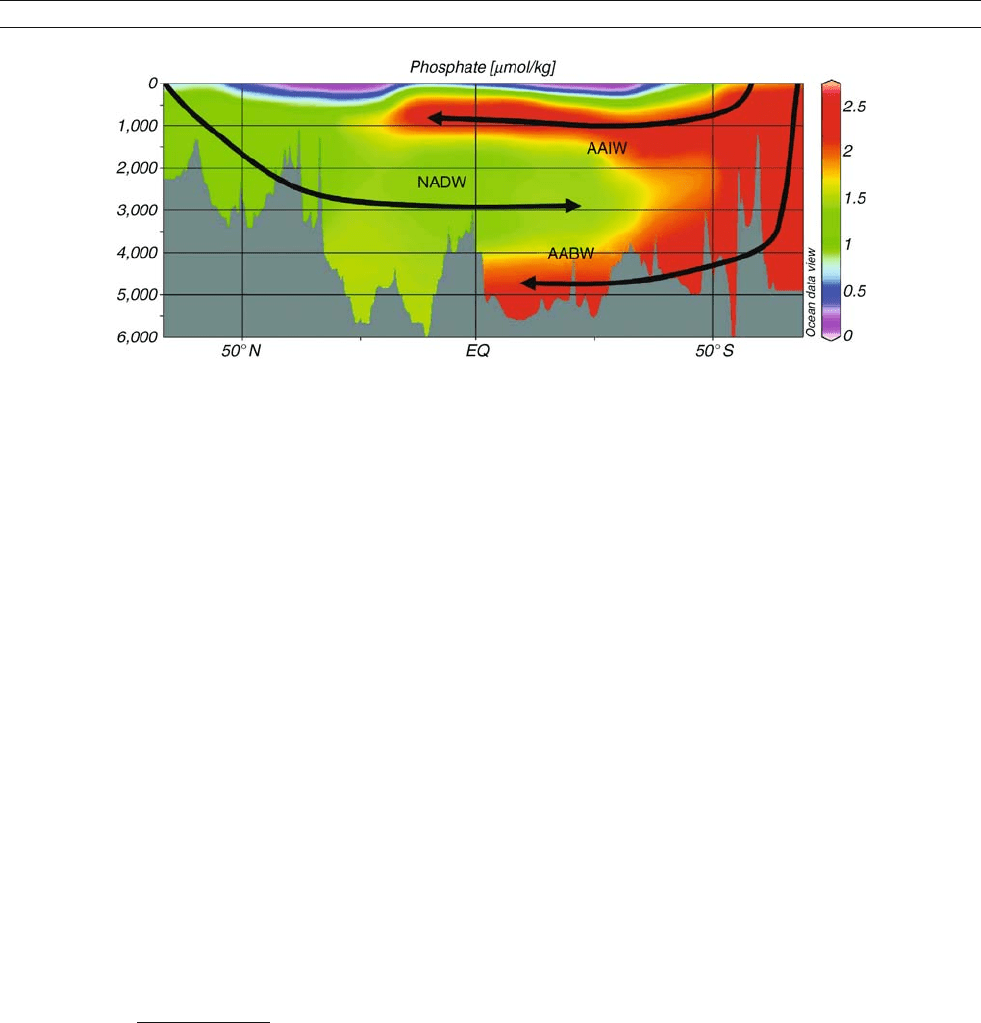
changes in deep water nutrient concentrations, we could deduce
the relative importance of these two water masses in the past.
However, past changes in deepwater nutrient concentrations
are not directly recorded in marine sediments. Instead, one
has to find chemical and isotopic signatures (i.e., nutrient con-
centration proxies) that correlate closely with dissolved nutrient
concentrations and become incorporated in marine archives
(i.e., benthic foraminifera, deep-sea corals, or sediments). The
most often used water mass proxies are the carbon isotopic
composition (d
13
C) of dissolved inorganic carbon and the dis-
solved concentration of several biologically recycled trace
metals (Cd, Zn, Ba), which are recorded in the isotopic and
chemical composition of benthic foraminifera and deep-sea
corals that grow in contact with bottom water. Neodymium iso-
tope ratio ( e
Nd
) has also been used. Unlike the previous tracers,
e
Nd
is recorded in the oxide coatings of settling particles that
accumulate on the seafloor and is not directly affected by
biological cycling.
d
13
C in benthic foraminifera
Carbon has two stable isotopes:
13
C(1.1%) and
12
C
(98.9%). Isotopic compositions are reported in the “delta”
notation, i.e.,
13
C/
12
C ratio expressed in permil deviation from
a standard taken as reference:
d
13
C
Sample
¼
13
C=
12
C
Sample
13
C=
12
C
Standard
1
2
6
4
3
7
5
1;000
During photosynthesis, dissolved inorganic carbon, nitrate and
phosphate are taken up by phytoplankton to produce organic
matter in surface waters. Because
12
C is taken up preferentially
to
13
C, the organic matter produced has a d
13
C value lower than
the d
13
C of inorganic carbon dissolved in surface waters. Upon
degradation and oxidation of organic matter in deep waters, the
dissolved inorganic carbon produced has a similarly “light” iso-
topic composition (i.e., low d
13
C). This isotopically light inor-
ganic carbon is regenerated concurrently with nitrate and
phosphate, resulting in a negative linear correlation between
the nitrate or phosphate concentration and the d
13
C of dissolved
inorganic carbon in deep waters (Kroopnick, 1985;
Figure O9a). The d
13
C of inorganic carbon dissolved in bottom
waters is recorded by the carbon isotopic composition of the
calcium carbonate produced by benthic foraminifera living
on the seafloor, which thus indirectly record nutrient concen-
trations in bottom waters. By measuring the d
13
C of benthic
foraminifera that lived in the past at different water depths,
it is thus possible to reconstruct past changes in the d
13
C
of seawater and deduce past changes in the concentration
and vertical distribution of nutrients in deep waters (Sarnthein
et al., 2001).
Cd/ Ca, Ba/Ca and Zn /Ca ratios in benthic foraminifera
or deep-sea corals
A similar principle can be applied to certain trace metals. Cad-
mium (Cd) is biologically recycled with phosphorus, resulting
in a tight positive correlation between phosphate and dissolved
Cd concentration in seawater (Figure O9b). As Cd becomes
incorporated in biogenic carbonate minerals in proportion to
its concentration in ambient seawater, the Cd/Ca ratio in fossil
benthic foraminifera (Boyle, 1988) and deep-sea corals (Adkins
et al., 1998) provides an independent means of reconstructing
past changes in bottom water nutrient concentration. As for
d
13
C, this information can be used to contrast the relative con-
tribution of NADW and AABW in the deep Atlantic Ocean, if
we assume (i) no changes in the preformed nutrient concentra-
tions in the water masses involved, and (ii) no changes in the
rate of organic matter remineralization in deep waters.
Barium (Ba) and zinc (Zn) are also biologically recycled,
but their regeneration from settling particles occurs at greater
depth than for Cd. Instead of tightly correlating with phosphate,
their seawater profiles mimic those of alkalinity or dissolved
silicate ( Figures O9c and O9d), which are controlled by the dis-
solution of carbonate and biogenic silica occurring in deeper
water. As for Cd, the concentration of dissolved Ba and Zn
in bottom water is recorded in the Ba/Ca and Zn/Ca ratios in
the shells of benthic foraminifera (Lea and Boyle, 1989;
Marchitto et al., 2000). Because of its deeper regeneration,
the contrast in Zn concentration between NADW and AABW
is more pronounced than for Cd. As a result, paired Zn
and Cd measurement in the same foraminifera shells provides
Figure O8 Latitudinal cross section of phosphate concentration in the Atlantic Ocean. The high phosphate concentrations in the two water
masses of southern origin, the Antarctic Intermediate Water (AAIW) and the Antarctic Bottom Water (AABW), stand out in sharp contrast to the
lower phosphate concentrations in the North Atlantic Deep Water (NADW).
636 OCEAN PALEOCIRCULATION
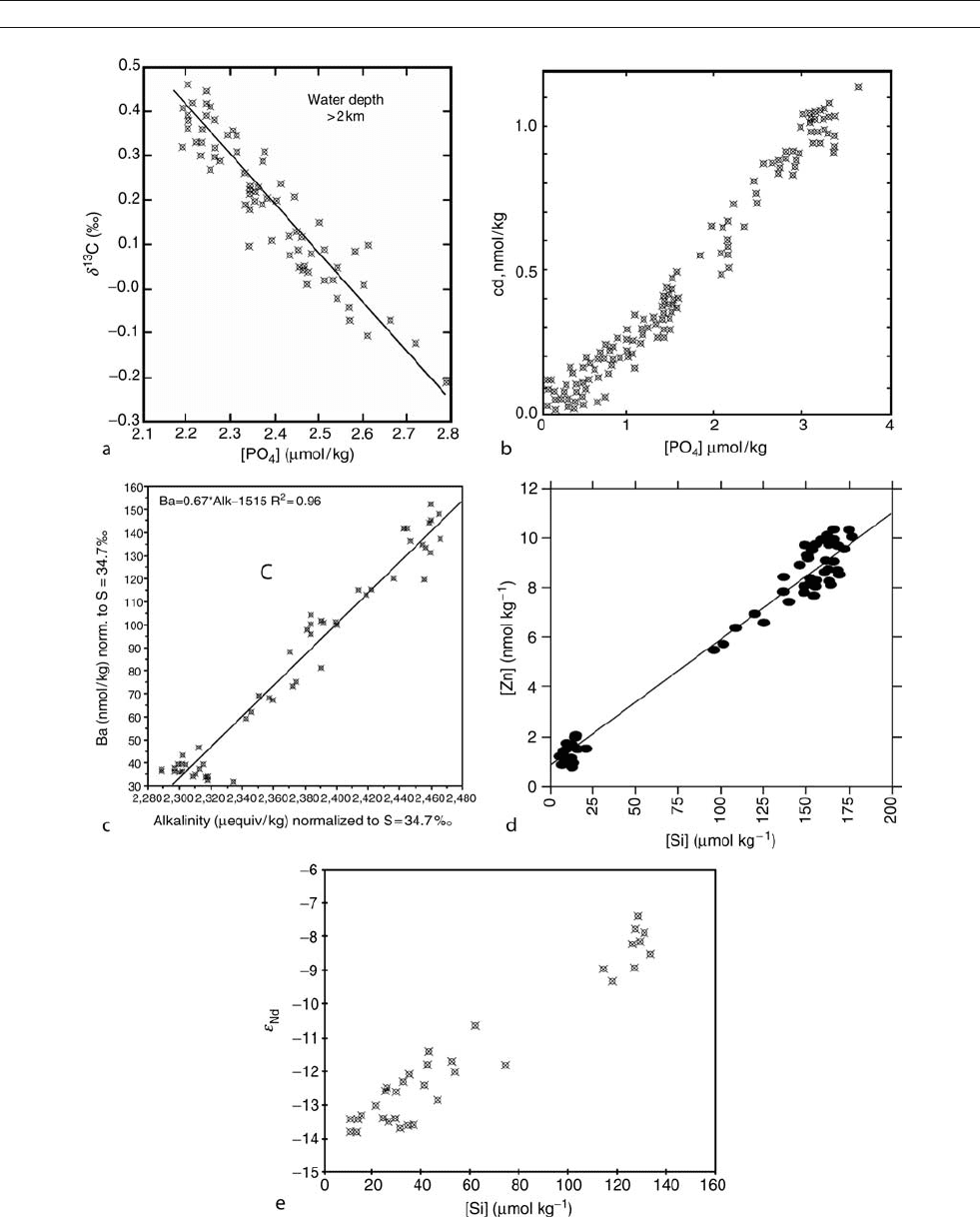
Figure O9 Correlations between seawater properties (nutrient concentration and alkalinity) and proxies used for their paleoceanographic
reconstruction. (a) d
13
C of dissolved inorganic carbon vs phosphate concentration in deep water (adapted from Broecker and Maier-Reimer, 1992).
(b) Dissolved cadmium vs. phosphate concentration in subsurface waters (adapted from Boyle, 1986). (c) Dissolved barium vs. alkalinity in surface
and deep waters (adapted from Lea, 1993). (d) Dissolved zinc vs. dissolved silicate concentration in seawater deeper than 1,000 m (adapted from
Marchitto et al., 2000). (e) e
Nd
vs. dissolved silicate concentration in the deep Atlantic Ocean (adapted from Rutberg et al., 2000).
OCEAN PALEOCIRCULATION 637

a means of distinguishing between changes in AABW pen-
etration and changes in preformed nutrient concentration
(Marchitto et al., 2002).
Neodymium isotopic ratio (e
Nd
) in sedimentary oxides
Neodymium isotopic composition is reported as:
E
Nd
ðÞ
Sample
¼
143
Nd=
144
Nd
Sample
143
Nd=
144
Nd
Standard
1
"#
10
4
Seawater e
Nd
reflects Nd input from nearby continental masses
(von Blanckenburg, 1999). Deep waters formed in the North
Atlantic acquire a Nd isotopic composition (e
Nd
¼13.5)
clearly distinct from that of the deep waters originating from
the Southern Ocean (e
Nd
¼7). There is a positive linear cor-
relation between e
Nd
and silicate concentration (Figure O9e)
in the deep Atlantic, reflecting a two end-member mixing
between NADW (low silicate concentration and low e
ND
) and
AABW (high silicate, high e
ND
). Dissolved Nd is removed from
seawater by adsorption on iron and manganese oxides that
precipitate in seawater and coat settling particles. The Nd isoto-
pic composition associated with oxides, which can be chemi-
cally leached from sediment, thus provides a complementary
means of estimating the northward penetration of deep waters
of southern origin, which is independent of the biological recy-
cling of nutrients (Rutberg et al., 2000). This is important,
because changes in the concentration of the nutrient-related
tracers described above could be affected by biological recy-
cling, independently of circulation.
Kinematic proxies for estimating rates of circulation
Several proxies that provide information on changes in circula-
tion rates have also been developed. They include (a) recon-
struction of the
14
C/
12
C ratio in the atmosphere, (b) paired
planktonic-benthic
14
C age differences, (c)
14
C ages of
230
Th-
dated deep-sea corals, (d) geostrophic flow reconstructions
from benthic foraminifera d
18
O, and (e)
231
Pa/
230
Th in Atlantic
sediments.
14
C/
12
C ratio in the atmosphere
14
C is a radioactive isotope of carbon that is continuously pro-
duced in the atmosphere by cosmic rays (cosmic rays are pro-
tons that shatter nuclei of atoms in the atmosphere, producing
neutrons that become incorporated into the nuclei of nitrogen
atoms while ejecting a proton; as a result
14
N becomes
14
C).
After formation,
14
C enters the global carbon cycle and decays
with a half-life of 5,730 years, thereby providing a clock to
date carbon-containing samples during the last 50,000 years.
However, accurate dating must take into account past variations
in the
14
C/
12
C ratio of the atmosphere (expressed as D
14
C
atm
;
see Radiocarbon dating). To that end, D
14
C
atm
has been
reconstructed for the past 50,000 years (Hughen et al., 2004)
by measuring the
14
C/
12
C ratio of samples that could be
independently dated (tree rings,
230
Th-dated corals, annually-
layered sediments, marine sediments correlated to the precise
timescale of Greenland ice cores). An important fraction of
D
14
C
atm
variability results from variations in the intensity
of the Earth’s magnetic field; these affect the influx of cosmic
rays and hence the production rate of cosmogenic nuclides like
14
C. This variability can be estimated from paleomagnetic data
(e.g., Laj et al., 2002). Additional D
14
C
atm
variability can also
result from changes in the rate of deepwater formation, which
affect the residence time of
14
C in the atmosphere. Thus, the
residual between the reconstructed history of D
14
C
atm
and the
D
14
C
atm
predicted from the changes in the intensity of the geo-
magnetic field can be attributed to changes in the rate at which
14
C is transferred from the atmosphere to the deep sea as a
result of deep water formation (Hughen et al., 2004). D
14
C
atm
higher than predicted from paleomagnetic data indicates slower
rates of transfer of
14
C from the atmosphere to the deep sea,
reflecting lower rates of deep-water formation. However, changes
in the air-sea exchange rate of
14
C, in the solar component of
14
C production modulation, and in the terrestrial carbon reservoir,
together with the effect of the biological export of
14
Ctothe
deep sea, must also be considered.
Paired planktonic-benthic
14
C age differences
14
C age differences between the fossil shells of planktonic (i.e.,
living in surface waters) and benthic (i.e., living on the sea-
floor) foraminifera recovered from the same sediment horizon
and presumed to be contemporaneous can potentially provide
quantitative information on past changes in deepwater renewal
rates. Larger differences in age have been taken to indicate
older deep waters and slower renewal rates (Keigwin and
Schlegel, 2002).
There are two potential complications, however, with that
approach. One stems from the variability in D
14
C
atm
with time.
Although the planktonic and benthic foraminifera are contem-
poraneous, the benthic species are growing in water that was
in contact with the atmosphere at an earlier time when D
14
C
atm
may have been different. The
14
C/
12
C ratio of the benthic and
planktonic foraminifera cannot thus be compared directly but
one must take into account this difference in initial conditions
(Adkins and Boyle, 1997). The second complication may be
even more problematic to resolve. It arises from the fact that
foraminifera do not acquire their carbon directly from the atmo-
sphere. Instead, their carbon source is inorganic carbon dis-
solved in ambient seawater. The
14
C/
12
C ratio of surface
waters, where planktonic foraminifera grow, is controlled by
exchange of CO
2
with the atmosphere and mixing with older
dissolved inorganic carbon from below. As a result, the
14
C/
12
C ratio of oceanic surface waters and planktonic forami-
nifera is lower than that of the contemporaneous atmosphere.
In the modern ocean, at low to mid latitudes, surface waters
have a
14
C/
12
C ratio that corresponds to an age of 400 years.
This so-called “reservoir age,” however, can be significantly
larger at high latitudes (up to 1,300 years), particularly in the
Southern Ocean, where upwelling rates of older deeper waters
are higher and CO
2
exchange with the atmosphere is limited
by extensive sea ice cover (Bard, 1988). Because deep water
is formed at high latitudes, benthic foraminifera growing on
the seafloor at low to mid latitude record a
14
C/
12
C ratio
that has been affected by a significantly older “reservoir age”
than their contemporaneous planktonic counterparts living in
surface water. This difference must also be considered when
calculating the ventilation age of deep water.
14
C ages of
230
Th-dated deep-sea corals
Some species of corals live at great depths, sometimes as deep
as 4,000 m. They can be dated by measuring the growth of
230
Th from the decay of
234
U included in the coral’s carbonate
lattice. Decay-correcting
14
C/
12
C measured in the same coral
samples and comparing it to the corresponding
14
C/
12
C ratio
of the atmosphere thus provides a means of estimating the
638 OCEAN PALEOCIRCULATION
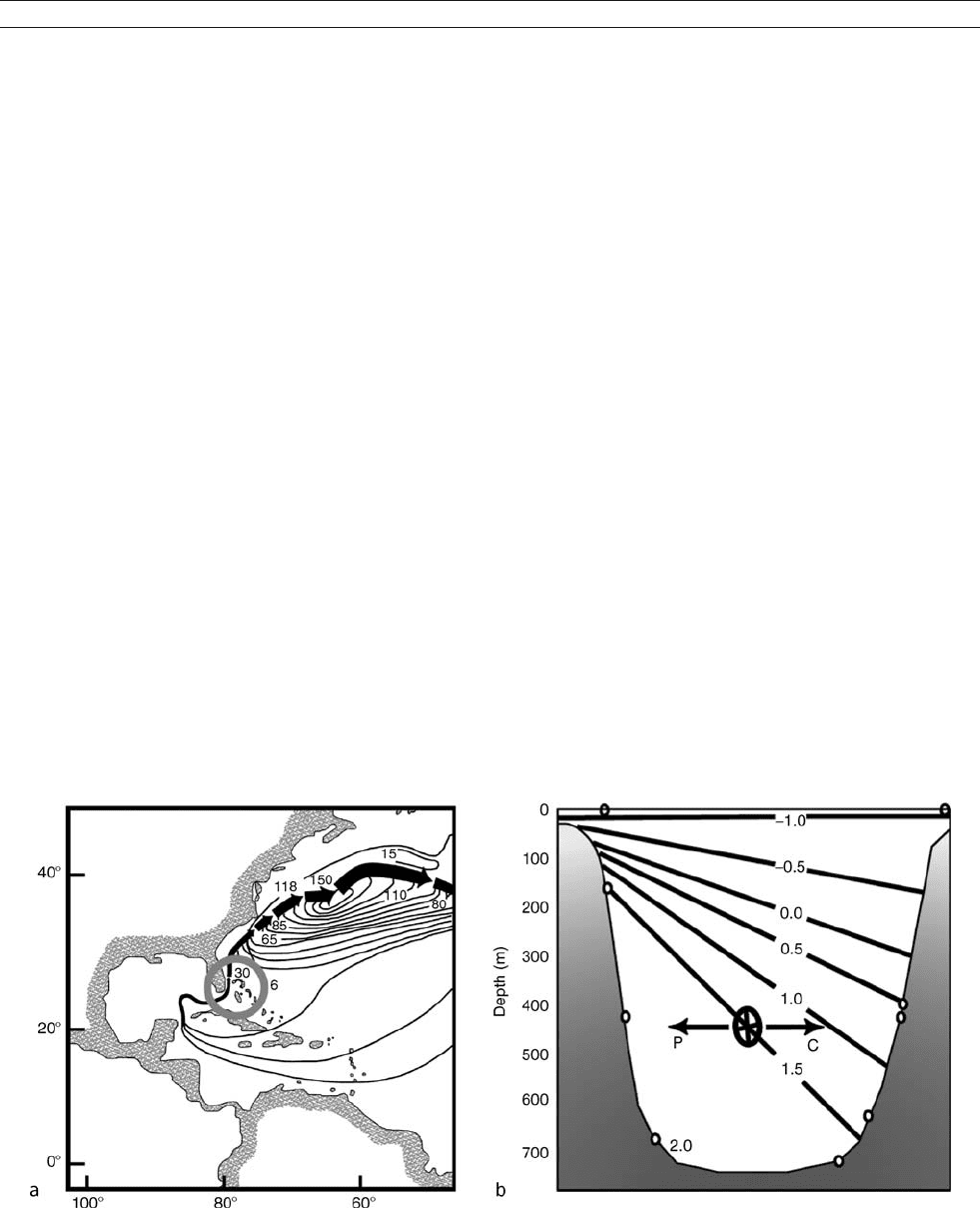
age of deep water (Adkins et al., 1998). These estimates must
also take into account possible changes in “reservoir age” and
the variability in D
14
C
atm
. However, unlike the sedimentary
archives, which provide continuous but relatively low resolu-
tion records (millennial to centennial timescales, depending
on the sedimentation rates), deep-sea corals provide narrow
(150 years dictated by the life span of coral specimens) but
high-resolution (decadal-centennial timescales) windows on
past changes in deep water ages.
Geostrophic flow reconstructions from benthic
foraminifera d
18
O
Most of the warm water flowing to the far North Atlantic for
NADW formation is supplied by the Gulf Stream (Figure O10a).
The Gulf Stream enters the North Atlantic through the Florida
Strait at a flow rate of about 30 Sverdrups. As it moves to the
north, it is continually accrued by entrainment of water coming
from the North Atlantic Subtropical gyre, and its flow rate
increases gradually, reaching 150 Sverdrups as it turns eastward.
In the Florida Straits, the Gulf Stream is nearly in geostrophic
balance, i.e., the Coriolis acceleration associated with the flow
of water (C) is balanced by the lateral pressure gradient across
the Strait (P; Figure O10b). This pressure gradient is associated
with a lateral seawater density gradient and results in sloping
surfaces of constant seawater density, called “ isopycnals.” If
the flow rate of the Gulf Stream were to accelerate, the Coriolis
force would intensify. To maintain geostrophic balance, the
lateral pressure gradient would have to increase, which would
be reflected by steeper isopycnals. The slope of the isopycnals
across the Florida Straits can be estimated from the oxygen
isotopic composition (d
18
O) of benthic foraminifera living on
the seafloor on each side of the Straits, thereby providing a
means of estimating the flow rate of water through the Strait
in the geological past. To the extent that the contribution from
the subtropical recirculation gyre (Figure O10a) remained con-
stant, changes in flow rate in the Florida Strait could be used to
infer changes in the rate of NADW formation (Lynch-Stieglitz
et al., 1999). The main difficulties with this approach are
(a) ascertaining the contribution from the subtropical gyre, and
(b) the requirement that current velocity must be known at one
level taken as reference, which is very difficult to constrain for
past circulation (Wunsch, 2003).
231
Pa/
230
Th in Atlantic sediments
231
Pa and
230
Th are two natural radionuclides produced at con-
stant rates in seawater from the decay of dissolved uranium. Both
are rapidly adsorbed on settling particles and removed to the
underlying sediment (Figure O11). As
231
Pa has a lower affinity
for most marine particles than
230
Th, it has a residence time in
deep water approximately five times longer and equivalent to
the mean residence time of deep water in the modern Atlantic
(ca. 200 years). As a result, nearly 50% of the
231
Pa produced
in the NADW as it transits through the Atlantic is exported to
the Southern Ocean, while most of the
230
Th is removed in the
Atlantic sediment (Yu et al., 1996). Reflecting this differential
export, the mean
231
Pa/
230
Th of Atlantic sediments (activity ratio
0.05) is only slightly above half the ratio of the rate of produc-
tion of the two nuclides in the water column (0.093).
231
Pa/
230
Th
in Atlantic sediments can thus record the rate at which NADW is
produced and exported to the Southern Ocean. As the rate
of NADW formation and export decreases, the extent of
231
Pa export to the Southern Ocean also diminishes, resulting in
higher
231
Pa/
230
Th in Atlantic sediments (Marchal et al., 2000).
The interpretation of this proxy is complicated, however, by
the fact that the removal rate of
231
Pa from seawater depends on
particle flux and composition. Lower
231
Pa/
230
Th in Atlantic
sediments could also be due to higher particle flux or higher
concentration of opal, a biogenic mineral produced by some
plankton species. Past changes in particle flux and composition
in the Atlantic Ocean must therefore be taken into account when
Figure O10 (a) Gulf Stream and recirculation in the North Atlantic subtropical gyre with total transport streamlines in Sverdrups, adapted from
Worthington (1976). Red circle highlights the Florida Straits. (b) Cross-section in the Florida Straits showing sloping horizons of constant seawater
density obtained from the d
18
O of modern benthic foraminifera (sampling depths are marked by open circles). The geostrophic flow that prevails in
this region results from the balance between the Coriolis force due to the Earth’s rotation (C) and the lateral pressure gradient created by the
lateral density gradient (P). The cross indicates that the water flows away from the reader (adapted from Lynch-Stieglitz et al, 1999).
OCEAN PALEOCIRCULATION 639
